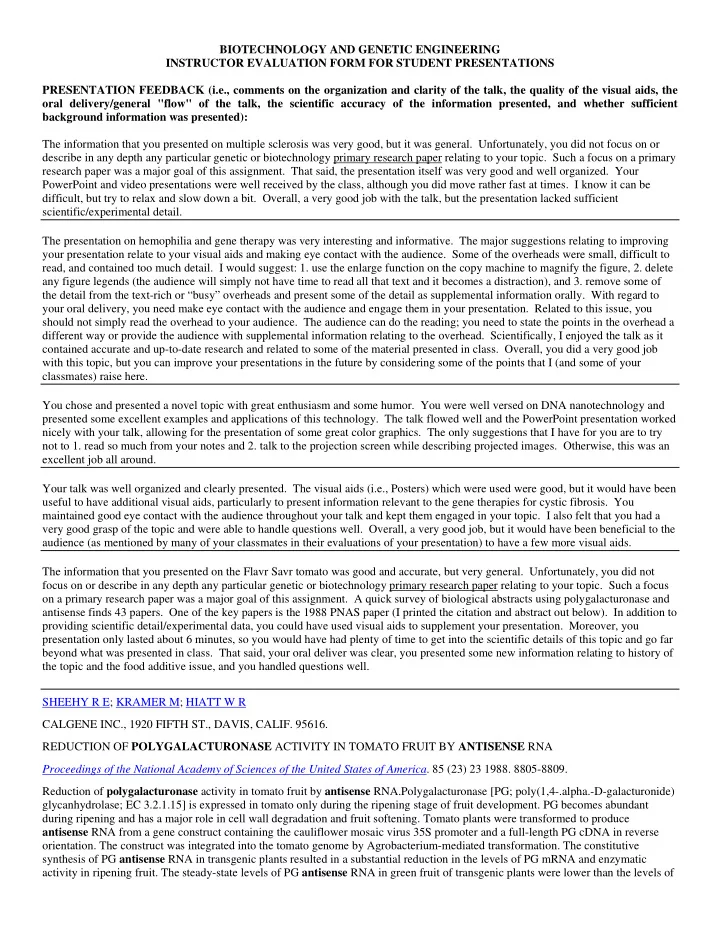

BIOTECHNOLOGY AND GENETIC ENGINEERING INSTRUCTOR EVALUATION FORM FOR STUDENT PRESENTATIONS PRESENTATION FEEDBACK (i.e., comments on the organization and clarity of the talk, the quality of the visual aids, the oral delivery/general "flow" of the talk, the scientific accuracy of the information presented, and whether sufficient background information was presented): The information that you presented on multiple sclerosis was very good, but it was general. Unfortunately, you did not focus on or describe in any depth any particular genetic or biotechnology primary research paper relating to your topic. Such a focus on a primary research paper was a major goal of this assignment. That said, the presentation itself was very good and well organized. Your PowerPoint and video presentations were well received by the class, although you did move rather fast at times. I know it can be difficult, but try to relax and slow down a bit. Overall, a very good job with the talk, but the presentation lacked sufficient scientific/experimental detail. The presentation on hemophilia and gene therapy was very interesting and informative. The major suggestions relating to improving your presentation relate to your visual aids and making eye contact with the audience. Some of the overheads were small, difficult to read, and contained too much detail. I would suggest: 1. use the enlarge function on the copy machine to magnify the figure, 2. delete any figure legends (the audience will simply not have time to read all that text and it becomes a distraction), and 3. remove some of the detail from the text-rich or “busy” overheads and present some of the detail as supplemental information orally. With regard to your oral delivery, you need make eye contact with the audience and engage them in your presentation. Related to this issue, you should not simply read the overhead to your audience. The audience can do the reading; you need to state the points in the overhead a different way or provide the audience with supplemental information relating to the overhead. Scientifically, I enjoyed the talk as it contained accurate and up-to-date research and related to some of the material presented in class. Overall, you did a very good job with this topic, but you can improve your presentations in the future by considering some of the points that I (and some of your classmates) raise here. You chose and presented a novel topic with great enthusiasm and some humor. You were well versed on DNA nanotechnology and presented some excellent examples and applications of this technology. The talk flowed well and the PowerPoint presentation worked nicely with your talk, allowing for the presentation of some great color graphics. The only suggestions that I have for you are to try not to 1. read so much from your notes and 2. talk to the projection screen while describing projected images. Otherwise, this was an excellent job all around. Your talk was well organized and clearly presented. The visual aids (i.e., Posters) which were used were good, but it would have been useful to have additional visual aids, particularly to present information relevant to the gene therapies for cystic fibrosis. You maintained good eye contact with the audience throughout your talk and kept them engaged in your topic. I also felt that you had a very good grasp of the topic and were able to handle questions well. Overall, a very good job, but it would have been beneficial to the audience (as mentioned by many of your classmates in their evaluations of your presentation) to have a few more visual aids. The information that you presented on the Flavr Savr tomato was good and accurate, but very general. Unfortunately, you did not focus on or describe in any depth any particular genetic or biotechnology primary research paper relating to your topic. Such a focus on a primary research paper was a major goal of this assignment. A quick survey of biological abstracts using polygalacturonase and antisense finds 43 papers. One of the key papers is the 1988 PNAS paper (I printed the citation and abstract out below). In addition to providing scientific detail/experimental data, you could have used visual aids to supplement your presentation. Moreover, you presentation only lasted about 6 minutes, so you would have had plenty of time to get into the scientific details of this topic and go far beyond what was presented in class. That said, your oral deliver was clear, you presented some new information relating to history of the topic and the food additive issue, and you handled questions well. SHEEHY R E; KRAMER M; HIATT W R CALGENE INC., 1920 FIFTH ST., DAVIS, CALIF. 95616. REDUCTION OF POLYGALACTURONASE ACTIVITY IN TOMATO FRUIT BY ANTISENSE RNA Proceedings of the National Academy of Sciences of the United States of America . 85 (23) 23 1988. 8805-8809. Reduction of polygalacturonase activity in tomato fruit by antisense RNA.Polygalacturonase [PG; poly(1,4-.alpha.-D-galacturonide) glycanhydrolase; EC 3.2.1.15] is expressed in tomato only during the ripening stage of fruit development. PG becomes abundant during ripening and has a major role in cell wall degradation and fruit softening. Tomato plants were transformed to produce antisense RNA from a gene construct containing the cauliflower mosaic virus 35S promoter and a full-length PG cDNA in reverse orientation. The construct was integrated into the tomato genome by Agrobacterium-mediated transformation. The constitutive synthesis of PG antisense RNA in transgenic plants resulted in a substantial reduction in the levels of PG mRNA and enzymatic activity in ripening fruit. The steady-state levels of PG antisense RNA in green fruit of transgenic plants were lower than the levels of
Recommend
More recommend